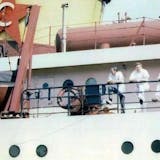Ronald Reagan was president and "The Cosby Show" reigned supreme on TV when the long list of polluted "areas of concern" in the Great Lakes was compiled in 1987. But so little progress has been made on environmental cleanup since then that the list reads essentially the same today as it did more than a quarter of a century ago.
Of the 43 sites identified in the northern United States and southern Canada, just five (three of them in Canada) have been restored to the point where they've been taken off the list. At 38 of these sites, the legacy of less-enlightened practices widespread before clean-water regulations — mostly, improper waste disposal and unchecked land use — continues to impair economic development and recreational use of the Great Lakes region's rivers, estuaries and lakeshore.
The disheartening lack of progress is why the recent announcement about an aggressive new cleanup plan for one of the largest and most challenging of these polluted sites — the St. Louis River estuary and bay — is a historic moment and deserving of support by both the public and policymakers.
If Minnesota and its project partners follow through on the "Roadmap to Delisting" released this summer, the restoration of an iconic river known as the headwaters of Lake Superior could be complete enough to be taken off the list in just 12 years. That would be a remarkable feat given that the St. Louis, which empties into Lake Superior between Superior, Wis., and Duluth, is still suffering from contaminated sediment and damaged habitat resulting from about a century of pre-regulatory-era industrialization, growth and dredging.
Among the sites targeted for action: a U.S. Steel Superfund site on a wide spot in the river known as Spirit Lake. Shipping companies, lumber operations and other companies that are part of the area's industrial heritage also left a legacy of challenges for the river's health.
If successful, the river's restoration could become one of the most significant environmental cleanups in state history. Its success also could spur other areas across the region to renew their commitment to cleaning up remaining sites. The St. Louis watershed is the only Minnesota site on the list, but 31 other sites still dot the shorelines of Wisconsin, Illinois, Indiana, Michigan, Ohio and New York, with the other locations in Canada.
Thanks to the 2008 Legacy Amendment, Minnesota has a competitive edge over other areas when it comes to Great Lakes restoration grants from the federal government, a key reason the aggressive 2025 delisting date is doable.
Part of the money generated by this self-imposed sales tax is dedicated to clean-water projects and habitat restoration, with the St. Louis effort exactly the big, farsighted effort that voters had in mind when they approved it. Having a reliable source of state funds to put on the table when applying for federal grants makes Minnesota requests stand out, enabling the state to garner many more millions, according to the state Pollution Control Agency.


